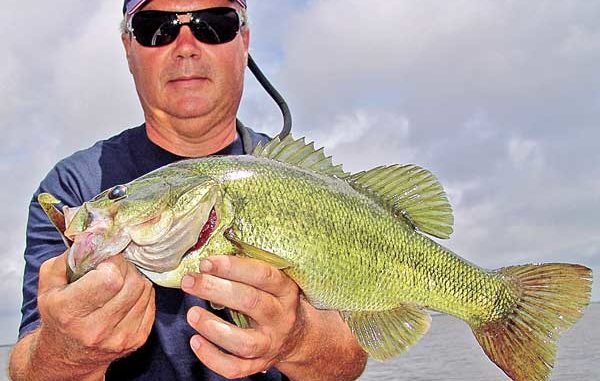
The things that make it tough to catch bass when they’re spawning makes it a lot more fun to go fishing after the spawn.
In North Carolina, June is probably one of the best months of the year for a bass fisherman to be on the lake. There are a lot of different patterns working — some late spawners, some fish shallow. You still find lots of fish on docks and shallow points, working their way toward the dropoffs.
But what makes fishing so good is that they’re hungry. They’ve spawned and quit eating for a while, they’ve been sick and they’re getting better, and finally, they want to eat. They get ganged up when they get to feeling better, and they’ll compete for the food that’s available. That’s why, when you find one, you usually find a lot — and most of them will bite.
When they first leave spawning pockets, bass will get on little rocky points and corners, then they’ll move on out. It can change pretty quickly. Usually, the bite on a good place like that will last about a week, then it will go away, but it will get better somewhere else. And if an area has held more spawning fish, the corners they use on the way back to deep water will be even more productive.
One thing you can count on is finding some fish shallow early in the morning. In many lakes around North Carolina, shad will spawn in late May and early June. When the shad go to the bank, the bass will be right behind them — at least for the first hour or two after the sun comes up. The food is right there for the taking, and a bass will take advantage of it. That’s when something like a Johnny Rattler or a Skitterpop will work real good.
When that’s over, you can look for the fish to move a little deeper every week. You might start out fishing a DT-10 crankbait, then a DT-14, and by the end of the month, you might be fishing a DT-16. They’ll get a little deeper every week. They’re still in the creeks for most of June, but by the end of the month, they’ll start on main-lake places.
You really need to use your electronics this month, not to see fish, but to find good drops — more than just cover. Bass don’t necessarily have to have cover in June. What they really like to do is get on real sharp drops. If you know where there’s a real sharp drop or break, they can be easy to find. You find a place where the water drops from four to eight feet in the length of your boat, or maybe six to 10 feet, and there’s a good chance that it’s going to hold fish.
One of the basic things that relates to all bass fishing is that you catch fish by fishing where they are, when they’re eating. In June, the baitfish are usually moving a lot, and maybe they will be on one spot for 30 minutes, then they’re gone for 30 minutes.
When the bait is on a spot where there is a gang of bass, they’re going to be feeding. That’s why you can pull up to a place and catch ’em one after the other, then the bite stops because the bait has moved. You might come back later, and if you hit it right and a school of shad is passing by, you’ll catch ’em again.
Most of the time, all the bass on a spot will be about the same size, and you’ll find better fish on one point than on another. I don’t know why, but it happens.
Having current has a lot to do with how often bass will feed. Wherever they can hold where there’s a little current to sweep bait into their area, that’s good.
Most of the time when June arrives, I like my boat sitting in about 15 feet of water so I can throw into four or five feet. By the end of June, I might be sitting in 23 to 24 feet of water, throwing into about 10.
Because bass are feeding pretty strong on shad, I’ll use blue-pearl, shad colors or chartreuse-brown. Most of the time, the water is going to be fairly clear, so that’s doesn’t have a big impact on what color you choose.
Big, soft-plastic baits fished on a Carolina rig or Texas rig will work. And a jig will work if bass are holding around docks when they come off. When I leave the ramp, I’ve usually got a Zoom Big Dead Ringer on one rod, a lizard on another, a jig on another, one with a topwater, then about four with different crankbaits tied on. That’s all you need, because that will catch just about all the bass you want this month.
David Fritts is a 52-year-old bass pro from Lexington. He was the 1993 Bassmasters Classic champion, the 1994 BASS Angler of the Year, and winner of the 1997 FLW Tour Championship. He is sponsored by Tums, Ranger boats, Evinrude outboards, Rapala, VMC hooks, Zoom, American RodSmiths and Bass Pro Shops.




Be the first to comment